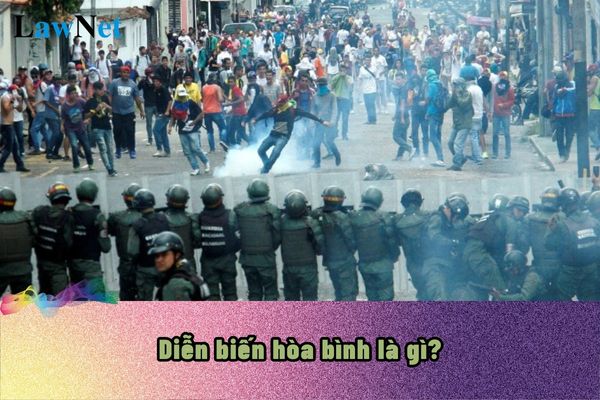Vietnam: What does peaceful evolution mean? Will upper secondary school students learn about peaceful evolution in the National Defense and Security Education curriculum?
What does peaceful evolution mean?
"Peaceful evolution" is a term frequently used to describe a strategy of gradually changing a nation's political policies through non-violent means, often implemented from within.
*Main characteristics of peaceful evolution:
Gradual Change: Unlike color revolutions, peaceful evolution is typically a long-term process requiring patience and perseverance.
Non-violence: Methods employed are primarily peaceful measures such as propaganda, advocacy, and organizing social and cultural activities...
Internal Change: The goal is to influence citizens' consciousness, weaken their trust in current policies, thereby provoking internal changes within the system.
Utilization of Multiple Means: peaceful evolution can employ various means such as media, education, economy, and culture to achieve its objectives.
*Objectives of peaceful evolution:
Overthrow Policies: The ultimate goal is to weaken and overthrow the prevailing political policies.
Change Ideology: Impact citizens' thoughts and beliefs, changing their perceptions about the current policies.
Build a New System: The ultimate aim is to establish a new political system that aligns with the goals of those undertaking peaceful evolution.
*Common methods used in peaceful evolution:
Propaganda and Advocacy: Spread ideas and viewpoints opposing current policies.
Organize Social Activities: Create organizations and social movements to attract public participation.
Attack Important Areas: Economy, culture, education...
Use of Media: Disseminate negative information and images about current policies.
*Note: The information on peaceful evolution is for reference only./.

What does peaceful evolution mean? Will upper secondary school students in Vietnam learn about peaceful evolution in the National Defense and Security Education curriculum? (Image from the Internet)
Will upper secondary school students in Vietnam learn about peaceful evolution in the National Defense and Security Education curriculum?
According to Section 5 of the general education program for National Defense and Security Education, issued alongside Circular 46/2020/TT-BGDDT, the general content at the upper secondary level is outlined as follows:
*Topics
General Knowledge about National Defense and Security
Curriculum content in class:
-
History and Traditions of the People's Armed Forces of Vietnam (Grade 10)
-
Basic Contents of Some Laws on Vietnam's National Defense and Security (Grade 10)
-
Drugs and Their Dangers (Grade 10)
-
Prevention and Combat of Traffic Safety Law Violations (Grade 10)
-
National Security Protection and Ensuring Social Order and Safety (Grade 10)
-
Some Knowledge on Cybersecurity (Grade 10)
-
Protection of National Sovereignty, Borders of the Socialist Republic of Vietnam (Grade 11)
-
Prevention of Social Evils in Vietnam during International Integration (Grade 11)
-
Issues of Environmental Law Violations (Grade 11)
-
Laws on the Management of Weapons, Explosives, and Supporting Tools (Grade 11)
-
Military Service Law and Students' Responsibilities (Grade 11)
-
Protecting the Socialist Republic of Vietnam after 1975 (Grade 12)
-
Organization of the People’s Army of Vietnam and the People’s Public Security of Vietnam (Grade 12)
-
Admission and Training in the People's Army of Vietnam and the People's Police Schools of Vietnam (Grade 12)
-
Some Understanding of the Strategy of peaceful evolution, and Hostile Forces’ Overthrowing of the Vietnamese Revolution (Grade 12)
-
Traditions and Warfare Arts of Local Defense (Grade 12)
Thus, according to the above regulations, upper secondary school students will learn about peaceful evolution in the 12th-grade National Defense and Security Education curriculum.
What are the general orientations to the teaching methods for National Defense and Security Education at the upper secondary level in Vietnam?
Under Section 6 of the general education program for National Defense and Security Education issued alongside Circular 46/2020/TT-BGDDT, the general orientations to the teaching methods for National Defense and Security Education at the upper secondary level in Vietnam are:
- Promote students' active, creative participation; avoid unilateral imposition and rote memorization; focus on fostering autonomy and self-learning capacities so students can explore, expand their knowledge base, and continue developing the necessary qualities and competencies after graduating from upper secondary education. Emphasize practicing the skills of applying national defense and security knowledge to identify and solve practical problems.
- Flexibly and creatively apply educational methods suitable to the educational objectives, content, student audience, and specific conditions. Teachers can combine multiple teaching methods within one topic.
Traditional teaching methods (lectures, conversations, etc.) are utilized in a way that encourages students' active and proactive participation.
Enhance the use of advanced teaching methods based on exploiting achievements in science and technology in teachers' instruction and students' learning processes, particularly applying the ongoing digital technology revolution, information, and communication to highlight the students' role as the central learning subjects (discussion, role-playing, practice, etc.).
Diverse and flexible teaching methods are implemented, combining individual and group learning, in-class and out-of-class learning.
Teachers and students engaged in studying National Defense and Security subjects need skills to exploit and refer to domestic and international defense and security knowledge through officially licensed electronic information portals by the Ministry of Information and Communications, aiming to consolidate, supplement and promptly update new knowledge, serving the learning, research, and teaching processes.

